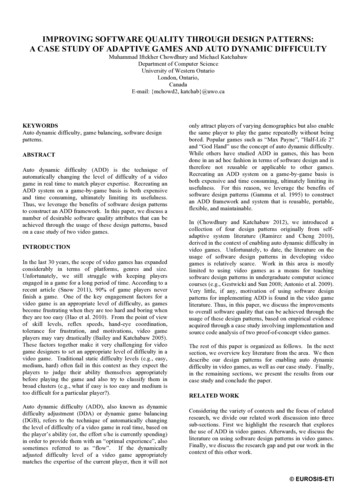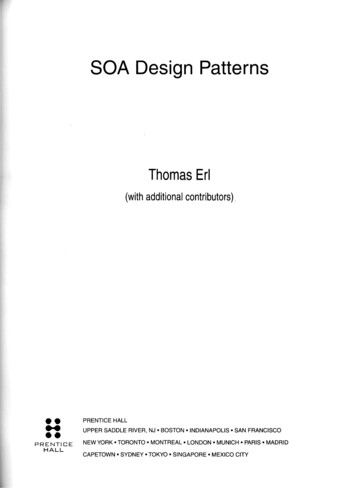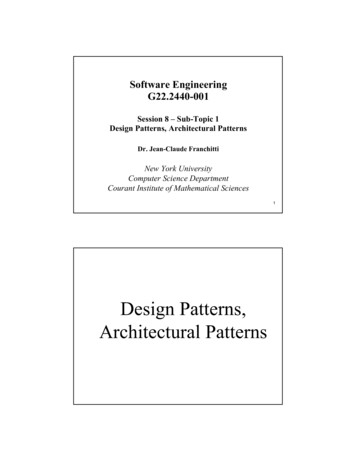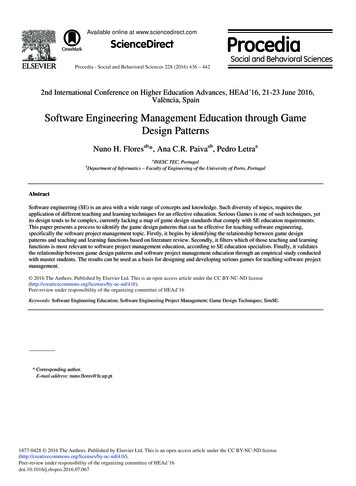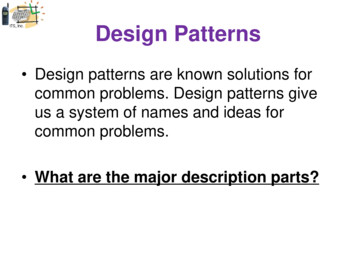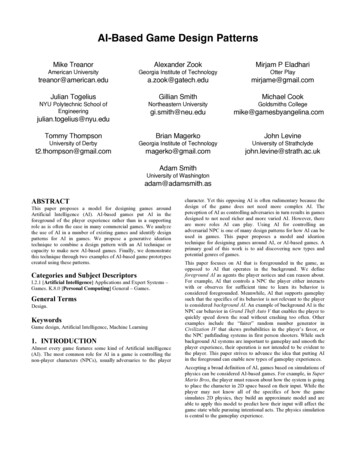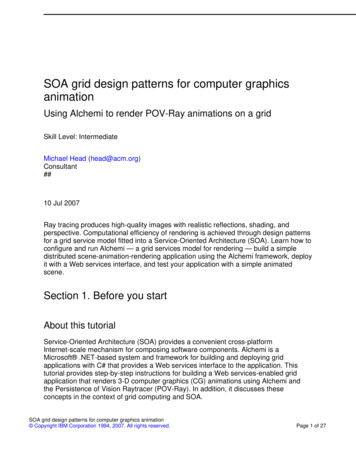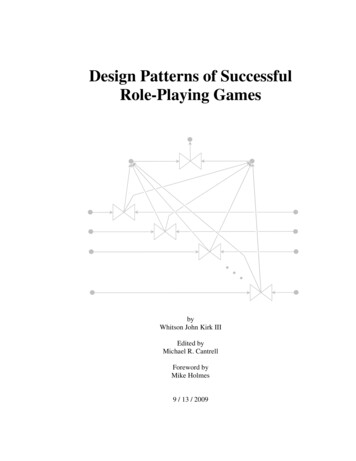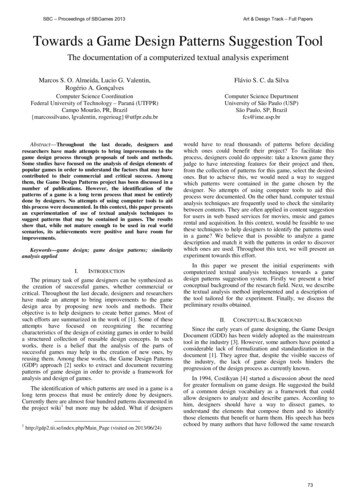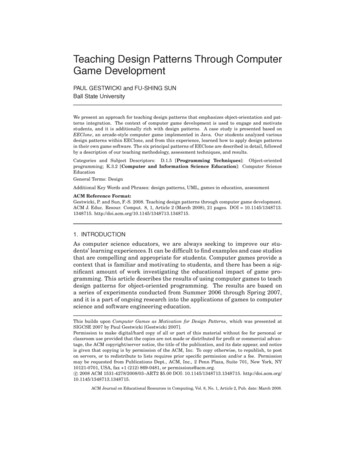
Transcription
Teaching Design Patterns Through ComputerGame DevelopmentPAUL GESTWICKI and FU-SHING SUNBall State UniversityWe present an approach for teaching design patterns that emphasizes object-orientation and patterns integration. The context of computer game development is used to engage and motivatestudents, and it is additionally rich with design patterns. A case study is presented based onEEClone, an arcade-style computer game implemented in Java. Our students analyzed variousdesign patterns within EEClone, and from this experience, learned how to apply design patternsin their own game software. The six principal patterns of EEClone are described in detail, followedby a description of our teaching methodology, assessment techniques, and results.Categories and Subject Descriptors: D.1.5 [Programming Techniques]: Object-orientedprogramming; K.3.2 [Computer and Information Science Education]: Computer ScienceEducationGeneral Terms: DesignAdditional Key Words and Phrases: design patterns, UML, games in education, assessmentACM Reference Format:Gestwicki, P. and Sun, F.-S. 2008. Teaching design patterns through computer game development.ACM J. Educ. Resour. Comput. 8, 1, Article 2 (March 2008), 21 pages. DOI 10.1145/1348713.1348715. http://doi.acm.org/10.1145/1348713.1348715.1. INTRODUCTIONAs computer science educators, we are always seeking to improve our students’ learning experiences. It can be difficult to find examples and case studiesthat are compelling and appropriate for students. Computer games provide acontext that is familiar and motivating to students, and there has been a significant amount of work investigating the educational impact of game programming. This article describes the results of using computer games to teachdesign patterns for object-oriented programming. The results are based ona series of experiments conducted from Summer 2006 through Spring 2007,and it is a part of ongoing research into the applications of games to computerscience and software engineering education.This builds upon Computer Games as Motivation for Design Patterns, which was presented atSIGCSE 2007 by Paul Gestwicki [Gestwicki 2007].Permission to make digital/hard copy of all or part of this material without fee for personal orclassroom use provided that the copies are not made or distributed for profit or commercial advantage, the ACM copyright/server notice, the title of the publication, and its date appear, and noticeis given that copying is by permission of the ACM, Inc. To copy otherwise, to republish, to poston servers, or to redistribute to lists requires prior specific permission and/or a fee. Permissionmay be requested from Publications Dept., ACM, Inc., 2 Penn Plaza, Suite 701, New York, NY10121-0701, USA, fax 1 (212) 869-0481, or permissions@acm.org.c 2008 ACM 1531-4278/2008/03–ART2 5.00 DOI: 10.1145/1348713.1348715. http://doi.acm.org/!10.1145/1348713.1348715.ACM Journal on Educational Resources in Computing, Vol. 8, No. 1, Article 2, Pub. date: March 2008.
2: 2·P. Gestwicki and F.-S. Sun1.1 Design PatternsDesign patterns provide solution strategies for general problems in objectoriented software engineering. These patterns were discovered in successfuldesigns and most famously cataloged by Gamma et al. over a decade ago[Gamma et al. 1995]. Despite an active patterns community and an abundance of research on patterns education and practice, patterns still tend to beunderrepresented in undergraduate education.There has been significant research regarding the teaching of design patterns in the computer science introductory sequence. This work ranges fromcase studies such as the games Set [Hansen 2004] and Life [Wick 2005] to complete curricular revisions [Decker 2003]. Many of the SIGCSE Nifty Assignments are used to teach specific design patterns and software architectures.The consensus is that through the use of appropriate case studies, combinedwith effective teaching techniques, students in the introductory sequence canlearn patterns. That is, they do not have to be relegated to upper-level courseson principles of software engineering.Personal experience indicates that students are often unable to comprehendpatterns from isolated examples. In a graduate-level seminar on visualizationand design patterns, students were asked to develop sample applications toillustrate various patterns. Many of the students were unable to generateaccurate, isolated instances of the patterns [Gestwicki and Jayaraman 2005].This is not a coincidence: it is difficult to translate from the isolated examplesof Gamma et al. to the complex and multifaced pattern reifications encountered in practice. Instead, patterns are best taught by presenting them insoftware of significant scale that contains collaborations among patterns. Thisbelief is supported by the literature: case studies have been used as a meansfor showing the definition, benefits, and costs of design patterns [Wick 2005;Dewan 2005], and some resources have also shifted from a dictionary presentation of patterns to illustrative examples [Holub 2004].1.2 GamesThe modern college freshman has grown up surrounded by the ever-growingcomputer game industry, and such games have become an integral part ofpopular culture. Our students have shown great interest in not only playinggames, but also in the interdisciplinary study of game design and development,including visual, audio, business, social, and technical aspects. It is unlikelythat this is a local phenomenon, as others have shown that using computergames as learning tools motivates students to learn topics they might otherwise avoid [Claypool and Claypool 2005].Commercially successful games are usually implemented in C or C , andthe techniques one encounters in game development magazines, books, and forums are usually tricks for squeezing a few more frames per second from a logicand rendering pipeline. In contrast, design patterns bring benefits in clarityand reusability, not (necessarily or by design) execution efficiency. While thevocabulary of patterns is certainly not absent from games, its concerns are frequently supplanted by the need for speed. This primacy of optimization resultsACM Journal on Educational Resources in Computing, Vol. 8, No. 1, Article 2, Pub. date: March 2008.
Teaching Design Patterns Through Computer Game Development·2: 3in code that is streamlined for one purpose. While these techniques are interesting and perhaps worthy of study for those interested in writing fast andsmall code, students benefit more from learning the process of abstraction anddesign than from language- and platform-specific tricks.The interdisciplinary nature of computer game design makes it difficult toincorporate into traditional computer science curricula. However, it would be amistake to disregard the study of games out-of-hand whether due to this complexity or the traditional stigma that they are “just games.” The key to successfor integration into existing programs (as opposed to the generation of gamespecific curricula) is to extract the computer science and software engineeringaspects from games.It is important to distinguish between game design, which is the processof developing a game idea [Salen and Zimmerman 2003], and game programming, which is the process of implementing game software [Gestwickiand Sun 2007]. The latter is clearly a domain of software engineering. Therehave been attempts to classify “design patterns” within game design [Bjorkand Holopainen 2004], but these are distinct from design patterns forobject-oriented software development. Since game programming using objectoriented techniques is an instance of object-oriented software engineering, onecan reasonably expect the traditional patterns to be applicable.1.3 Teaching with Games and PatternsUsing games to teach computer science is not a new idea. We have alreadymentioned some examples that use games to teach patterns, and there aremany more. However, many of the examples one encounters in textbooks andon the Web take shortcuts in the name of clarity and simplicity. For example, in a survey of recent Java textbooks, every game example performs all ofits rendering and logic processing on the event thread. This leads to simplercode, but it ignores the important programming idiom that the processing onthe event thread should be kept to a minimum. In small-scale or turn-basedgames with little or no animation, the impact of this poor design decision isnot apparent. However, this approach does not scale to action-oriented games,which must maintain good frame rates while being responsive to user input.As an example, consider the game loop. Computer games are driven by acentral loop that is similar to the event-processing loop in all modern interactive software. It can be summarized by the following pseudocode:while the game is runningupdate the game elementsredraw the screenThis loop demonstrates active rendering, a technique in which the maingame loop draws the screen directly. Many Java examples found both onlineand in print use passive rendering, where the paint or paintComponent methodof each game element handles its own drawing, as in AWT or Swing applications. When using passive rendering, screen drawing is dependent upon theACM Journal on Educational Resources in Computing, Vol. 8, No. 1, Article 2, Pub. date: March 2008.
2: 4·P. Gestwicki and F.-S. SunFig. 1. Two annotated screenshots of EEClone. On the left, the player’s sprite is seen in themiddle of the screen, dodging the flying block obstacles. On the right, the player has triggeredan explosion, and the chain reaction of explosions is evident. The circles emanating from theexplosions are the bonus sprites that the player can collect for extra points.event thread, and so there is no guarantee of frame rate, which leads to unsteady animations.The pseudocode presented above is deceptively simple: the difficulty ingame programming comes from balancing game logic processing and rendering within the game loop. In order for a game to achieve smooth animations,whether it is an action game or an animated puzzle game, the game loop needsto repeat as many as 70 to 90 times per second [Davison 2005]. This upperlimit synchronizes the scene drawing with the refresh rate rate of modern display devices. A well-designed game engine will be able to maintain a steadyframe rate by a combination of active rendering, double-buffering, and, whennecessary, dropping frames.1.4 Overview of EECloneEEClone was developed as a case study to both explore and teach design patterns. Two screenshots are provided in Figure 1. It was inspired by EveryExtend, a free game for Microsoft Windows published by Omega.1 Commercial versions of the game have been recently released by Q Entertainment forPlayStation Portable and XBox Live Arcade. In the game, the player controlsa bomb in a world filled with flying obstacles. If the player strikes an obstacle,a life is lost. If the player detonates the bomb, a life is still lost, but it alsostarts a chain reaction of explosions, which earns the player points and morelives. Some obstacles drop bonuses when destroyed, and these can be picked upfor extra points. However, the amount of points needed to earn extra lives increases. A key aspect of the gameplay involves dodging obstacles until a largeenough chain reaction can be created, all while the timer counts down. Part ofwhat makes the game fun is this trade-off between risk and reward. EECloneis a simplified clone of Every Extend, borrowing its interface paradigm but1 http://nagoya.cool.ne.jp/omegaACM Journal on Educational Resources in Computing, Vol. 8, No. 1, Article 2, Pub. date: March 2008.
Teaching Design Patterns Through Computer Game Development·2: 5using simplified graphics and scoring. It was implemented in Java withoutusing any native libraries.EEClone was chosen as an example because the rules are simple, it is extensible, and it contains many of the features of more complex games. The gamerequires smooth animation, score keeping, responsive controls, music, soundeffects, and collision processing. From its inception, EEClone was designedto be simpler than Every Extend but also extensible, so that interested students could build on the software to add new features. That is, it was designedspecifically to support software reuse and extensibility, two oft-cited benefits ofobject-orientation and design patterns.2. PATTERNS IN EECLONESeveral patterns are reified in EEClone. The game’s software architecture is acollaboration of patterns, but for clarity, each pattern is first described in isolation. The method by which patterns are presented here mirrors the methodused to discuss the patterns within our experiment: a discussion of the domainspecific problem leads to a justification for the design pattern. The softwaredesigns are presented using the Unified Modeling Language (UML) [Boochet al. 2005]. Design patterns are identified within class diagrams using theUML collaboration notation. This is an effective and semantically correct useof the notation and useful for highlighting the collaborative nature of designpatterns.2.1 Sprites: The State PatternA sprite is any non-background element in a game, such as players, enemies,and projectiles. In EEClone, the player, obstacle blocks, explosions, and headsup display are all considered sprites by the game engine. Sprites lend themselves to object-oriented design: they have state and they exhibit behaviors.The state of a sprite, generally, includes its location, velocity, size, and image. The behaviors of sprites usually correspond to either user input for playersprites or collisions with the player for enemy sprites.Sprites often exhibit different behaviors based on external or internal gameinformation. For example, Pac-Man behaves differently after eating a PowerPellet than before. A state diagram for the player’s sprite in EEClone is presented in Figure 2. The traditional implementation strategy, exhibited in everytextbook surveyed, is to use integer constants to represent each possible state.Then, in each method whose behavior is state-dependent, the program uses ifor switch statements to explicitly detect the current state and take the appropriate behavior. This procedural approach carries with it all the usual baggage:state-dependent logic is distributed throughout the code, making the additionof new states both awkward and error-prone.The patterns-based alternative is the State pattern, where each state is represented by its own object. Figure 3 provides an architectural view of this approach. Each state is implemented in its own class, which encapsulates andlocalizes each state’s behavior. All messages sent to the player sprite are delegated to the current state object. In Java, these states are implemented asACM Journal on Educational Resources in Computing, Vol. 8, No. 1, Article 2, Pub. date: March 2008.
2: 6·P. Gestwicki and F.-S. SunFig. 2.State diagram for the EEClone player’s sprite.Fig. 3. The State pattern applied to player state representation. The player sprite can be in oneof four states, each of which is implemented as an anonymous inner class of PlayerSprite.private anonymous inner classes, which has the benefits of hiding the detailsof states within the containing class and also ensuring that there is only oneinstance of each state object. The relationship between a class and its innerclasses is indicated using a bidirectional UML containment association. Thisis a relatively uncommon notation, but it is semantically appropriate for representing inner classes [Holub 2004].This design incorporates an important yet easily overlooked property of theState pattern: states are responsible for their own transitions [Gamma et al.1995]. The state transitions can be modeled as a directed graph, and each stateis only aware of its neighbors.ACM Journal on Educational Resources in Computing, Vol. 8, No. 1, Article 2, Pub. date: March 2008.
Teaching Design Patterns Through Computer Game Development·2: 7Fig. 4. The Facade pattern, which hides the details of the game implementation behind a singlepoint of entry. The game logic implementation details are hidden from the client. A representativesample of classes within the game logic implementation are shown.2.2 Logic vs. Presentation: The Facade PatternWhen programming in Java, one may deploy a game as an applet or as an application, and applications can use windowed mode, full-screen exclusive mode(FSEM), or “almost full-screen” mode [Davison 2005]. These decisions are related to the presentation and have only minor effect on the game logic. Also,there are situations when one would want to switch easily between presentations: debugging a game intended for FSEM can be easier in windowed mode,for example. Although the separation of concerns is clear, many code samplesin print and on the web combine presentation and game logic into one class,presumably to simplify or shorten the code.Figure 4 shows how the facade pattern can be used to hide the game logicbehind the Game class. Using this design, the game’s “wrapper” (a full-screenwindow, an applet, etc.) can be changed without affecting the game logic, andthe game logic can be changed without affecting its wrapper. This design canbe used to build a game architecture in which the game logic is a replaceablemodule [Nguyen and Wong 2002].2.3 Controls: The Observer PatternThe classic example of the observer pattern in Java uses the java.awt.eventclasses to process events. Listeners are registered with event producers, andevents are fired and handled on the AWT-Event Thread. Our experience showsthat students have little trouble understanding event-driven programming atthis level. However, when there is nontrivial processing to be done in responseto an event, the best practice is to push this processing onto a different thread.Many students fail to grasp this lesson, latching instead onto a naı̈ve interpretation of the Observer pattern in which the observer reacts to the stimulusimmediately and on the same thread.Smooth animation and consistent, responsive input can be achieved with amore clever application of the Observer pattern. Java’s standard libraries donot provide a platform-independent approach for polling the keyboard’s state.ACM Journal on Educational Resources in Computing, Vol. 8, No. 1, Article 2, Pub. date: March 2008.
2: 8·P. Gestwicki and F.-S. SunFig. 5. The Observer pattern applied to asynchronous processing of keyboard input. The eventthread posts the status of keys, which is read by each update in the main loop of the game thread.One must use the AWT KeyListener to receive keyboard events unless linkingwith a native library such as JInput.2 In order to maintain a smooth animation, the speed of a sprite must be defined with respect to the number ofupdates per second, not the number of key events per second. An elegant solution to this problem is for the key listener to write key state information toa shared object, and for the main game thread to read the state of this objectduring the update step, as illustrated in Figure 5. This demonstrates how theobserver pattern can be used in a multithreaded environment, and this architecture can be applied in nongame applications as well. This is also an exampleof multithreaded processing that does not require synchronization: thread synchronization would introduce unnecessary overhead considering the frequencyof updates and the atomicity of assignment.2.4 Animation: The Strategy PatternIn an object-oriented implementation of a game, sprites should be responsiblefor rendering themselves. One could combine the logic and presentation ina single class, but this would make it difficult to add or modify animationslater. For example, one method of animation is to load a series of images andflip through them; another approach is to render each frame of an animationusing graphics primitives. If the animation logic is mixed with the sprite’sstate logic, it would be very difficult to alter.An alternative is the Strategy pattern. The architecture of such a solutioninvolves an Animation interface, attaching animations to sprites at runtime,and delegating the rendering from the sprite to the animation object. Thisapproach is illustrated in Figure 6, where a sprite’s animation update and2 https://jinput.dev.java.netACM Journal on Educational Resources in Computing, Vol. 8, No. 1, Article 2, Pub. date: March 2008.
Teaching Design Patterns Through Computer Game Development·2: 9Fig. 6. The strategy pattern applied to sprite animation.rendering are delegated to an animation strategy, identified by the Animationinterface. When this design is combined with the state design of Figure 3, eachstate of the player sprite may have its own animation strategy, and the corresponding animation is only updated and rendered when its state is active. It isworth mentioning that the current version of EEClone uses Java2D graphicsprimitives, not image-based animations. This is intended as an entry point forstudents to modify the provided code.2.5 Collisions: The Visitor PatternGames often contain a variety of elements that can collide with each other, andthe result of the collision depends on the elements’ types. Consider again theclassic Pac-Man: our intrepid hero can collide with walls, ghosts, power pellets,dots, and fruit. Using a non-OO approach, the types of game elements can beencoded as integers and then selected via switch. The disadvantages of thisapproach are similar to those for the state problem discussed earlier: the logicfor collisions is spread throughout the game, and there is no static verificationthat all collisions are considered. An alternative in Java is to use instanceofto obtain runtime type information, but this requires a rigid type hierarchywhere polymorphic dispatch is preferable.A pattern-based approach uses the Visitor design pattern. Many studentsbalk at this pattern’s polymorphic double-dispatch, but it is a natural fit forthe problem of handling sprite collisions, where the behavior of each collisionis dependent on the sprite’s type. We return to the EEClone game for a simpleexample, since there are only four types of sprites: the player’s sprite, explosionsprites, flying block (obstacle) sprites, and bonus sprites. Figure 7 shows howthe pattern is applied with respect to the player sprite and flying block spriteimplementations. Both of these classes have their own collisionHandler,which is itself a Visitor. The player sprite’s collision handler contains its logic:if it collides with a bonus sprite, bonus points are earned, and if it collides witha flying block, a life is lost. The flying block sprite’s collision handler watchesfor collisions with explosions, which result in the flying block’s own explosionand an increase in the player’s score. For both of these, collisions with othertypes of sprites do nothing, and so those visit implementations are empty. Ifspecial processing were required upon collision at a later date, it could easilybe added.ACM Journal on Educational Resources in Computing, Vol. 8, No. 1, Article 2, Pub. date: March 2008.
2: 10·P. Gestwicki and F.-S. SunFig. 7. The Visitor pattern applied to sprite collision processing. The SpriteManager checksfor bounding box collisions and delegates the handling of collisions to each sprite’s collidesWithmethod. The Sprite implementors serve as both Concrete Element and Client.Fig. 8.The Singleton pattern allows for any object in EEClone to modify music playback.2.6 Music Engine: The Singleton PatternThe Singleton pattern is applied when an object is both global and unique forits type. The apparent simplicity of its intention and implementation leads toits abuse by amateur software designers. We assert that it should be discussedin a course on design patterns precisely because it is so easily abused; a failureto adequately explore this pattern will likely lead to its continued misuse.In EEClone, a singleton is used for the object that manages music playback.This allows any object in the executable model to change the music that iscurrently played. The OggPlayer class is a singleton, as shown inbreak Figure 8. Although only the game states currently use this singleton, the patternallows for extensions to the game to be able to change or stop the music asrequired.ACM Journal on Educational Resources in Computing, Vol. 8, No. 1, Article 2, Pub. date: March 2008.
Teaching Design Patterns Through Computer Game Development·2: 11When presenting this pattern, we observed that our students accepted thisdesign without argument. The students were surprised to hear that anotherprofessional software designer had debated with us whether this is a good application of singleton or not. Our view is that it is reasonable to assume thatthere is one global entrypoint into the audio subsystem since the entire engineis based on the assumption that there is a single computer with a single setof speakers or headphones. However, one can imagine a case where a gamemust support different audio outputs, although our class could not immediately identify why one would want such a thing. This issue leads directly intoan important discussion about the broad assumptions one must make whenapplying the Singleton pattern. It is important in a discussion of design tobalance the desire for extensibility with the necessity of solving the problem athand. In this case, we assert that a singleton is the simplest solution, since extending the engine to a multiheaded or multiuser system significantly changesthe requirements and therefore the design of the entire game engine.The use of the Ogg Vorbis audio format provides a convenient point to initiate discussion of intellectual property. Students tend to have some understanding of the various audio codecs available, but few appreciate the legalimplications of codec selection. In this case, the choice of Ogg Vorbis was easy:it is free for perpetuity, and there are several tools available to convert audiointo its format. Embedding the codec logic into EEClone optimizes the sizeof the application and provides the detailed source for students who are interested. However, a more robust game engine could easily make use of anexisting audio engine such as OpenAL (http://openal.org).3. TEACHING, LEARNING, AND ASSESSMENTOur teaching philosophy is based on active learning principles, which haveshown to be useful in teaching computer science [McConnell 1996; Briggs 2005]and particularly software design [Warren 2005; Gibson and O’Kelly 2005]. Weengage students with a subject that is of interest to them so that they approachthe problems proactively via individual exploration, peer collaboration, smallgroup discussion, and other constructive means. To the students, game programming is both interesting and significant, and so students are motivated tosucceed. The instructors serve as facilitators and guides in this process [Bonwell and Eison 1991; Wilkerson and Gijselaers 1996]. To assess the learningresults from using these principles, we use formative assessments such as selfand peer-evaluation, a form of portfolio assessment, and presentations in addition to traditional summative assessments [Biggs 1999; Earl 2003].Design patterns provide a set of best-practices for object-oriented design,having been discovered in successful software systems [Gamma et al. 1995].One of the most important benefits of design patterns is that they facilitatecommunication: a potentially complicated software design can be conciselydescribed in terms of interacting patterns. This identifies three roles for design patterns in education: as examplars of object-oriented design, as practicaland useful solutions to software design problems, and as tools to communicateACM Journal on Educational Resources in Computing, Vol. 8, No. 1, Article 2, Pub. date: March 2008.
2: 12·P. Gestwicki and F.-S. Sunabout design. Based on these observations, we have defined the followinglearning objectives:(1) The student understands object-oriented design and modeling.(2) The student can identify and apply the specific design patterns addressedin this experiment.(3) The student can effectively communicate about software design and designpatterns.We have developed a variety of assessment tools to measure students’progress towards achieving these goals. Specifically, these are a multimodalentry exam, peer evaluation, in-class presentations, project milestone deliverables, and an exit exam.3.1 Entry ExamsThe entry exam was designed to measure students’ knowledge about design,including both declarative and procedural knowledge. It is insufficient for astudent to only have declarative knowledge about software design since it isinherently a process. Similarly, it is almost useless for a student to be able todesign if he or she cannot communicate about the design.The students’ declarative knowledge was assessed using a written exam,which was distributed on the first day of class and collected on the second.This instrument was designed to measure students’ knowledge of fundamental object-oriented design principles and design patterns. The exam providedseveral topic areas, for which the student was asked to provide an estimation of self-efficacy on a five-point Likert scale. Students were also askedto provide an example, in C or Java, to demonstrate this understanding.The list of topics in the written portion of the entry exam were: objectoriented software design, inheritance, polymorphism, UML, design patterns,and the difference between procedural and object-oriented design. Four specific design patterns were also mentioned by name: Singleton, State, Strategy,and Visitor.The results of the written exam met our expectation that the studentshad little or no knowledge of design patterns (by name). A surprising resultwas that students reported moderate understanding of principles of objectorient
have been attempts to classify "design patterns" within gamedesign[Bjork and Holopainen 2004], but these are distinct from design patterns for object-oriented software development. Since game programming using object-oriented techniques is an instance of object-oriented software engineering, one
